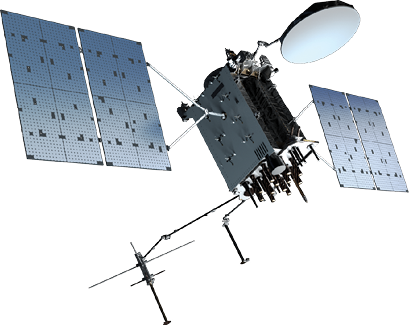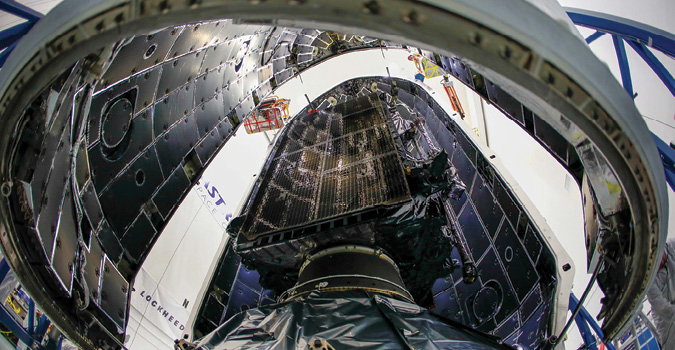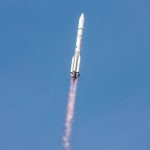The Pentagon has requested $1.3 billion in its fiscal 2024 budget for bolstering the GPS system, preparing new satellites for launch and moving to a new control system. The biggest changes will come with the new GPS IIIF satellites, still a few years away.
The U.S. Department of Defense (DOD) is continuing a major update for the GPS system, requesting $1.3 billion in the fiscal 2024 budget for GPS III satellite support and continuing the upgrade to the GPS III Follow On (GPS IIIF) enhanced satellite series and the next-generation control system. The upgrade will include greater accuracy and more military capability.
GPS III satellites, of which six are in orbit, already have a strengthened anti-jam capability and improved accuracy, along with the ability to tap into other civil GNSS signals, such as Europe’s Galileo. Planned upgrades will usher in a new search and rescue feature and a much more robust anti-jamming capability for troops in theater.
Especially with the fortified anti-jam capability, “this isn’t your grandmother’s GPS,” said Eric Brown, vice president of space mission strategy and advanced capabilities for GPS satellite builder Lockheed Martin.
The $1.3 billion fiscal 2024 request was significant enough for Secretary of Defense Lloyd J. Austin III to include it in his top-line highlights for the $842 billion fiscal 2024 defense budget. The funding, which must still be approved by Congress, continues support for GPS III satellites along with the planned upgrade, GPS IIIF.
The budgets for the program in fiscal 2022 and 2023 were $2 billion and $1.7 billion, respectively, including funding for three satellites in FY22 and two in FY23.
Lockheed Martin has completed work on its original GPS III 10-satellite contract and is under contract to provide up to 22 GPS IIIF satellites. The sixth GPS III satellite, GPS III Space Vehicle 06 (GPS III SV06), was launched in January, and the remaining satellites are in storage and waiting for the U.S. Space Force to call them up for launch.
The GPS III satellites continue to provide three-dimensional position, navigation and timing (PNT) for military and civilian users. They are backward compatible with earlier GPS satellites, but add the new Galileo-compatible signal for civilian users and the more powerful M-Code military signal.
Future Capability

In addition to the new L1C civil signal that’s compatible with Europe’s Galileo constellation, the GPS III satellites offer three times better accuracy, up to eight times improved anti-jamming capabilities and a modular design to allow new technologies and capabilities to be added in the future, according to Lockheed Martin. The GPS III signals are broadcast with greater accuracy due to enhanced atomic clocks.
GPS IIIF will add even more capability, starting with GPS IIIF SV11, likely to launch in late 2026. It will include:
- A Regional Military Protection (RMP) capability, which can boost anti-jamming ability in theater by up to 60 times, to make sure U.S. and allied forces can’t be denied access in hostile environments
- A laser retroreflector array that enhances accuracy
- A new search and rescue payload
- A fully digital navigation payload
- The new LM2100 Combat Bus, an enhanced satellite that provides even greater resiliency and cyber hardening, and improved spacecraft power, propulsion and electronics. Lockheed Martin’s Combat Bus will be available starting on GSP IIIF SV13, but it’s already in space as part of the Space Based Infrared System Geosynchronous Earth Orbit 5 satellite, or SBIRS GEO-5, which launched in May 2021 after five years of construction. SBIRS GEO-5 is part of the Space Force’s Overhead Persistent Infrared missile warning constellation, which detects missile launches, supports ballistic missile defense and collects signals intelligence.
OCX and MGUE
The Military GPS User Equipment (MGUE) gives users access to M-Code signals, providing secure and accurate PNT capabilities to warfighters for ground, aircraft, ships, and weapons systems, enabling continued operations in the most contested environments. The fiscal 2024 budget funds the testing and lead platform integration of MGUE Increment 1, design activities to address its pending obsolescence, and development for MGUE Increment 2.
The funding request for the fiscal 2024 budget also supports the ongoing move from the current Operational Control Segment to the GPS Next Generation Operational Control System, or OCX, which will provide command, control and mission support for the GPS constellation, including GPS III and all legacy satellites.
Raytheon Intelligence & Space is the lead contractor for both MGUE and OCX, having been awarded the original OCX contract more than a decade ago and the new OCX 3F contract in the summer of 2021.
The company said the OCX has implemented 100% of the information assurance standards from the U.S. Department of Defense, which gives it “the highest level of cybersecurity protections of any DOD ground-based system. The cyber-secure system will have improved accuracy with better international availability as well as globally deployed modernized receivers with anti-jam capabilities.”
The OCX has another benefit: It can support more than twice as many satellites as the legacy version, which, according to Raytheon, means “those additional satellites will increase coverage in hard-to-reach areas such as urban canyons and mountainous terrain.”
The OCX program is divided into blocks: Initially, Block 0, 1 and 2. Block 0 was delivered in 2017 and supported the launch of the first GPS III satellite a year later, using the OCX Launch and Checkout System, or LCS. The LCS has been used to launch three more GPS satellites since then.

Block 1 will provide full operational capability, including control of legacy satellites, and Block 2, which will be delivered concurrently with Block 1, will add operational control for the new L1C civil signal as well as the updated M-Code signals. Beyond that is OCX Block 3F, which will upgrade the system to synchronize with GPS IIIF satellites and MGUE Increment 2.
According to Air Force budget documents, “the OCX Block 3F effort will develop solutions necessary to launch, command, control, and monitor GPS IIIF spacecraft and include advance collection and integration of RMP high-power regional Military Code (M-Code) signals, rapid warfighter effects, and support to GPS IIIF auxiliary payloads (including Search and Rescue (SAR), Nuclear Detonation (NUDET) Detection System (NDS).”
RMP and SAR
The RMP high-power M-Code signals are what would boost anti-jamming capabilities in theater by up to 60 times. Andre Trotter, Lockheed Martin’s vice president of Navigation Systems, said, “it is a dish, and so we do have the ability to beam or focus a signal into an area of responsibility or an area of interest.” That focused beam will be “giving you a higher gain effect at the same time.”
“This is a set of capabilities that are able to operate in that kind of contested, challenging environment in a way that we wouldn’t have been able to do with the constellation five years ago,” Brown said. “Andre’s team has really been driving this new set of capabilities to respond to the challenges that GPS is facing today.”
That capability will come online with GPS IIIF SV11, as will the new payload for aiding search and rescue operations.
“The search and rescue payload is actually our first international payload, and it is something we have partnered with the Canadian government and also NOAA,” the National Oceanic and Atmospheric Administration, Trotter said.
The SAR payload will tap into the Cospas-Sarsat system of search and rescue satellites to geolocate emergency transponders and provide coordinates to rapidly assist users in distress. “If you are stranded somewhere in the Pacific Ocean or Gulf of Mexico, etc., we have the ability to receive that signal and pass that through the proper channels,” Trotter said. “That capability itself will be starting with SV11, so that will be the first vehicle in GPS IIIF.
“It was a perfect partnership with NOAA, the Canadian government…to add that to our platform,” Trotter said. “And so, from a positioning standpoint, from an availability perspective, it is definitely an upgrade, and it made a lot of sense for us to do so.”
Added Flexibility
Additional capabilities will be coming down the line once the LM LM2100 Combat Bus comes online with GPS IIIF SV 13. It will add greater flexibility to the GPS constellation, company officials said.
“We have the ability to integrate payloads later in the integration cycle, at a lower cost,” Brown said. “Whether it be environments change or threats change, or we have to change capabilities of our satellites, we have the ability to do so later in the timeline. …”
Trotter said the LM2100 Combat Bus brings with it “a tremendous increase in SWaP, size, weight and power, that can be accommodated. And as a result, we’re able to look at a variety of additional auxiliary payloads that are creating certainly a lot of interest across the customer communities.” This provides “the opportunity for GPS truly to be a multi-mission platform versus some of the limitations that we’ve had historically.”
Brown said that could include PNT-related demonstration payloads or “one that we’ve spoken about publicly in the past, is the equipping of the GPS IIIF vehicles with crosslinks allowing GPS to effectively function as a geodata transport network.”
Satellites based on the LM2100 Combat Bus can also host the Augmentation System Port Interface, or ASPIN, allowing satellites to be serviced and upgraded while on orbit.
“ASPIN is the front-end docking adapter that Lockheed Martin developed to allow us to integrate auxiliary payloads later in the process, and even once the vehicle is on orbit,” Brown said. “We recognize that the demands change over the lifecycle of a space vehicle, and…there’s a tremendous need to adapt over a period of time. ASPIN provides that opportunity. So, we’re working very closely with Space Force and others on on-ramping ASPIN into a number of platforms.”
“An analogue that you may think about is in the air domain,” Trotter said. “Every C-130, every F-35 has the opportunity to load different mission packages onboard. And depending on what the mission is really requiring, you would provide a different outfit of capabilities of sensors, weapons and so forth. What we’re trying to do is bring that same mentality into the space domain where you are not limited in terms of capability to what you had at the point of launch, but rather to remove payloads on orbit and then to be able to equip others at the same time.”

The Stewards
The team at Lockheed Martin are the stewards of this technology, Brown said, an important responsibility.
“We should never be satisfied with what we’ve got today,” he said, “but really looking forward to how we can continue improving upon GPS, so that we can improve all of those things, the economy, the way that people transport, and certainly the military advantages that we have, over time.”






